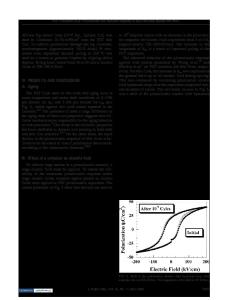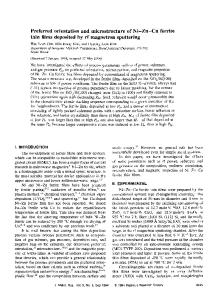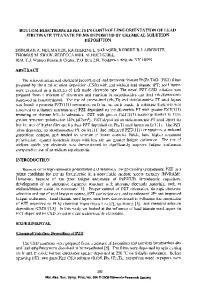Orientation Dependence of Strontium-doped Lead Zirconate Titanate (PSZT) Thin Films on RF Magnetron Sputtering Condition
- PDF / 366,155 Bytes
- 6 Pages / 612 x 792 pts (letter) Page_size
- 43 Downloads / 378 Views
0928-GG14-11
Orientation Dependence of Strontium-doped Lead Zirconate Titanate (PSZT) Thin Films on RF Magnetron Sputtering Conditions Sharath Sriram, Madhu Bhaskaran, Anthony Stephen Holland, and Geoffrey K Reeves Microelectronics and Materials Technology Centre, School of Electrical and Computer Engineering, RMIT University, GPO Box 2476V, Melbourne, Victoria, 3001, Australia
ABSTRACT Studies on strontium-doped lead zirconate titanate (PSZT) have been reported for its high piezoelectric and ferroelectric properties. For PSZT to exhibit pronounced piezoelectric behaviour it must have a crystalline grain structure (perovskite orientation). This paper is a study of the deposition of PSZT thin films by RF magnetron sputtering and the effect of cooling rate, after deposition at temperatures between 500 ºC and 700 ºC. X-Ray Diffraction (XRD) results are used to show how a cooling rate of 5 ºC/min increases the degree of perovskite orientation in sputtered films, when compared to a cooling rate of 15 ºC/min. The absence of significant shifts in the positions of diffraction peak patterns in XRD results are used to demonstrate low stress in the deposited films. Atomic Force Microscope (AFM) imaging is used to show the crystalline nature of the PSZT thin films.
INTRODUCTION Lead zirconate titanate Pb(Zr1-yTiy)O3 is a material that is known for its high piezoelectric and ferroelectric properties [1]. Thick and thin films of lead zirconate titanate (PZT) have been repeatedly used in a variety of piezoelectricity or piezoresistivity based sensors such as biosensing cantilevers [2] and pressure sensors [3]. Piezoelectricity is exhibited by compounds with ionic or partly-ionic bonds and lacking a centre of symmetry [3]. PZT is one of many ceramic compounds with a general ABO3 representation. Zirconium (Zr) and titanium (Ti) are B-site dopants of the compound. Certain A-site dopants (in place of a fraction of the lead atoms present in A-site locations) have been found to increase certain properties and introduce other properties. The compound of interest in this paper strontium-doped PZT (PSZT) has been reported to have improved piezoelectric, ferroelectric, dielectric tunability, and pyroelectric (infra-red radiation sensors by thermal effects) [4-7] behaviour. Published literature on studies of PSZT material focuses on pellets and powders [5,6]. However, the general consensus is that PZT and other doped-PZT compounds (e.g. PLZT and PNZT) can be deposited as thick or thin films under similar conditions, whether by sputtering or sol-gel techniques, as the percentage concentration of A-site dopants is generally very small. In the case of mixing powders to form pellets and film deposition using sol-gel solutions, a dominant film orientation is obtained by poling, performed by application of a high electric field (about 100 kV cm−1) across the film [8]. With the use of piezoelectric and ferroelectric films in microsystem sensors it is advantageous to reduce processing steps and the requirement of specialized equipment. Obtaining
Data Loading...










